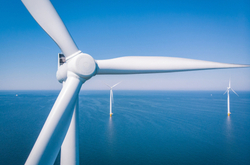World’s first telescopic wind turbine installed in the Canary Islands
Offshore wind turbines have many of the same advantages as their land-based counterparts. They generate renewable energy, create jobs, and don’t consume water or produce greenhouse gases. They even have added benefits, in that offshore wind speeds tend to be faster and steadier than on land, which translates to higher and more reliable energy production. However, there are also some significant drawbacks. Since they’re far removed from the shore, offshore wind turbines are more difficult and therefore also more costly to install and maintain. These shortcomings seem to now have been largely eliminated through the groundbreaking work performed by the EU-funded ELICAN project. It was launched in 2016 to further develop the high-capacity, low-cost substructure for offshore wind turbines spearheaded by an earlier EU initiative, ELISA. A year and a half later, project partners have succeeded in installing a pioneering offshore wind turbine with a telescopic tower in the Canary Islands. What makes the turbine one of a kind? The 5 MW turbine is the first bottom-fixed offshore wind turbine in southern Europe and the first in the world to be installed without using heavy-lift vessels. It has a self-floating gravity-based structure and a self-lifting telescopic tower. Both components are made of concrete, a durable material in the marine environment and just one of the cost-reducing elements in this innovative structure. According to a news item posted on the protective and marine coatings industry website ‘PaintSquare’, aA major advantage of the self-lifting telescopic tower is that it lowers the centre of gravity during the installation stages. Thanks to this advanced technology, the platform served as a stable floating barge, allowing each of the wind turbine’s units to be assembled onshore. This eliminated the need for large vessels or cranes during installation, reducing costs and drastically lowering the risks associated with assembly at sea. Once assembled, the turbine was towed to its location off the coast of Gran Canaria, one of Spain’s Canary Islands. Readily available tugboats were used to tow the structure into position, making hard-to-come-by and expensive heavy-lift vessels redundant. The platform was then ballasted to the seabed and the tower lifted to its final position using cables and heavy-lift strand jacks. The benefits The novel technology is expected to reduce the turbine’s carbon footprint by 30 % and achieve a more than 35 % reduction in costs relative to conventional practices. This method is also able to support installations involving larger turbines and increased water depths. “It is fantastic to be involved in such a unique and complex project,” said engineer Cecilio Barahona from project partner ALE Heavylift Iberica S.A. in a news item posted on the ‘Hydrogen Fuel News’ website. “We have developed specific solutions for all the challenges resulting from the project and reduced risk thanks to our engineering designs.” The ELICAN (SELF-INSTALLING TELESCOPIC SUBSTRUCTURE FOR LOW-COST CRANELESS INSTALLATION OF COMPLETE OFFSHORE WIND TURBINES. DEEP OFFSHORE 5MW PROTOTYPE) turbine is expected to become operational and start generating power later in 2018. For more information, please see: ELICAN project web page
Countries
Spain



